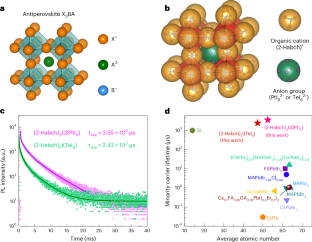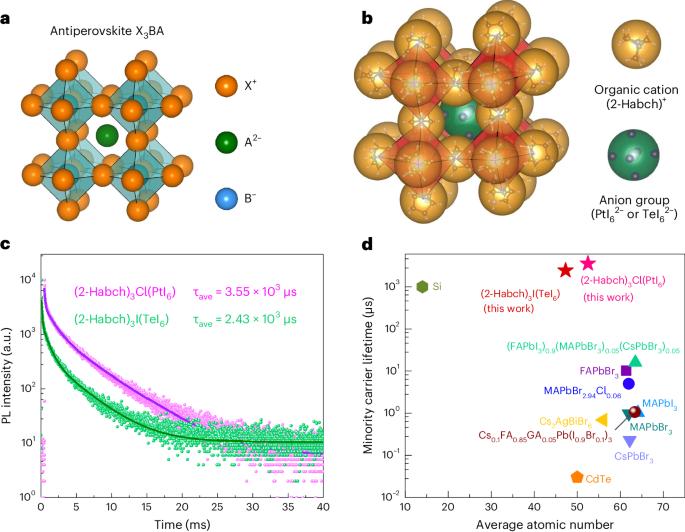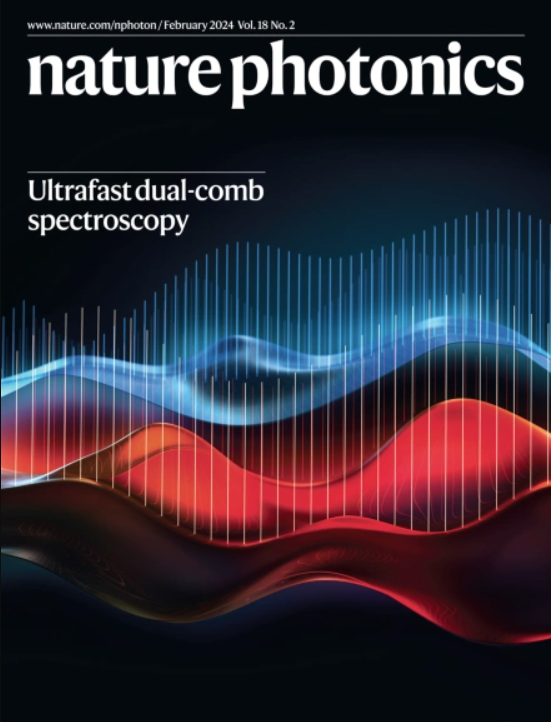用于超低剂量和稳定 X 射线探测的长载流子寿命反超晶石
IF 32.3
1区 物理与天体物理
Q1 OPTICS
引用次数: 0
摘要
卤化物过氧化物具有高 X 射线吸收系数、低阱态和方便的制造工艺,因此在直接 X 射线探测方面具有广阔的发展前景。然而,在单一材料中实现高灵敏度、低暗电流和低探测极限仍是一项挑战。其深层原因在于材料的μτ乘积和电阻率之间的权衡。在此,我们报告了一种有机-无机混合反超晶石((2-Habch)3Cl(PtI6))的构造,它具有间接转变和带边缘低轨道对称性,可实现超长的本征寿命,从而打破了这种权衡。(2-Habch)3Cl(PtI6)实现了前所未有的长载流子寿命(3 ms),从而产生了 6.25 × 10-3 cm2 V-1 的大μτ乘积和 1012 Ω cm 的高电阻率,优于大多数 X 射线探测材料。这些特性使得 X 射线探测器能够同时实现 0.21 nA cm-2 的超低暗电流、1.0 × 104 µC Gyair-1 cm-2 的高灵敏度、2.4 nGyair s-1 的超低探测极限,以及出色的工作稳定性,没有可观察到的基线漂移,性能优于最先进的过氧化物单晶探测器。基于反包晶石的 X 射线探测器在几乎所有性能指标上都实现了罕见的高性能组合,可用于新一代 X 射线探测系统。本文章由计算机程序翻译,如有差异,请以英文原文为准。


Anti-perovskites with long carrier lifetime for ultralow dose and stable X-ray detection
Halide perovskites have shown promising potential for direct X-ray detection due to their high X-ray absorption coefficient, low trap states and convenient fabrication process. However, it is still a challenge to achieve high sensitivity, low dark current and low detection limit in a single material. The deep reason for this is the trade-off between the material’s μτ product and resistivity. Here we report the construction of an organic–inorganic hybrid anti-perovskite ((2-Habch)3Cl(PtI6)) with indirect transition and low orbital symmetry at the band edge to achieve an ultralong intrinsic lifetime and thus break the trade-off. (2-Habch)3Cl(PtI6) achieves an unprecedented long carrier lifetime of >3 ms, leading to a large μτ product of 6.25 × 10−3 cm2 V−1 and high resistivity of 1012 Ω cm, outperforming most X-ray detection materials. These properties enabled the development of X-ray detectors that simultaneously achieve an ultralow dark current of 0.21 nA cm−2, high sensitivity of 1.0 × 104 µC Gyair−1 cm−2, ultralow detection limit of 2.4 nGyair s−1 and excellent operational stability with no observable baseline drift, outperforming state-of-the-art perovskite single-crystal detectors. The rare combination of high performance in almost every figure of merit in the anti-perovskite-based X-ray detector could enable new-generation X-ray detection systems. The researchers synthesize organic–inorganic hybrid inverse perovskites that exhibit excellent carrier lifetime and mobility–lifetime product and high resistivity, enabling stable X-ray detectors with performance arguably outperforming state-of-the-art perovskite single-crystal detectors.
求助全文
通过发布文献求助,成功后即可免费获取论文全文。
去求助
来源期刊

Nature Photonics
物理-光学
CiteScore
54.20
自引率
1.70%
发文量
158
审稿时长
12 months
期刊介绍:
Nature Photonics is a monthly journal dedicated to the scientific study and application of light, known as Photonics. It publishes top-quality, peer-reviewed research across all areas of light generation, manipulation, and detection.
The journal encompasses research into the fundamental properties of light and its interactions with matter, as well as the latest developments in optoelectronic devices and emerging photonics applications. Topics covered include lasers, LEDs, imaging, detectors, optoelectronic devices, quantum optics, biophotonics, optical data storage, spectroscopy, fiber optics, solar energy, displays, terahertz technology, nonlinear optics, plasmonics, nanophotonics, and X-rays.
In addition to research papers and review articles summarizing scientific findings in optoelectronics, Nature Photonics also features News and Views pieces and research highlights. It uniquely includes articles on the business aspects of the industry, such as technology commercialization and market analysis, offering a comprehensive perspective on the field.
 求助内容:
求助内容: 应助结果提醒方式:
应助结果提醒方式:


